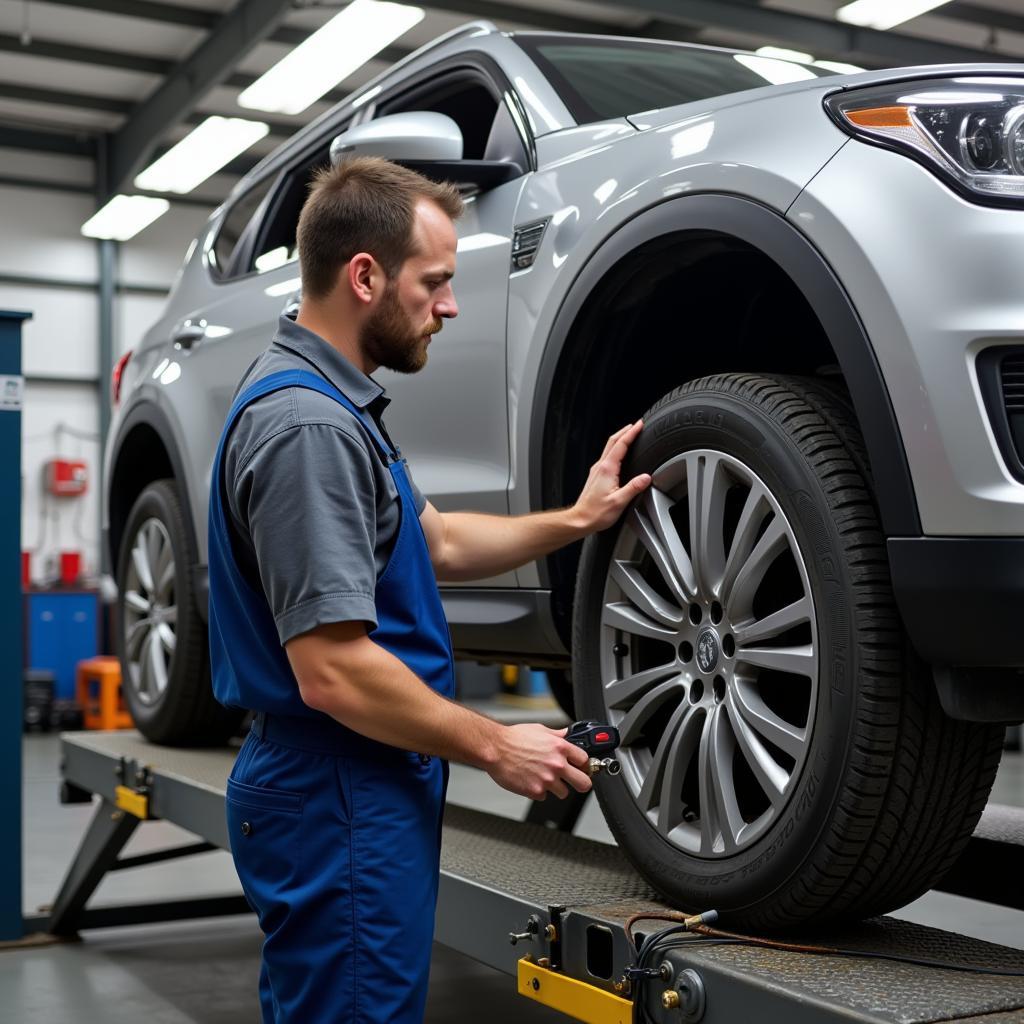Experiencing a Car Bumpy Ride Problem can be unsettling and even dangerous. A smooth ride is crucial for comfort and safety, and any deviation from this can signal underlying issues with your vehicle. This article aims to help car owners, mechanics, and technicians diagnose and fix the causes of a bumpy ride, providing practical solutions and expert advice.
A bumpy car ride can stem from various issues, ranging from simple tire pressure problems to more complex suspension malfunctions. Let’s explore some of the most common culprits and how to address them. For those experiencing issues with their car’s springs and dampers, checking for a constant horizontal speed issue can be a good starting point. Learn more about this at car and road spring and damper problem constant horizontal speed.
Identifying the Source of Your Car Bumpy Ride Problem
Tires: The First Place to Look
Tire pressure plays a vital role in ride quality. Under-inflated tires can create a bouncy, unstable feeling, while over-inflated tires can make the ride excessively harsh. Check your tire pressure regularly and ensure it matches the manufacturer’s recommendations, typically found on a sticker inside the driver’s side door jamb. Also, inspect your tires for uneven wear, bulges, or damage. A damaged tire can significantly contribute to a bumpy ride.
 Checking Tire Pressure for a Bumpy Ride
Checking Tire Pressure for a Bumpy Ride
Shocks and Struts: Absorbing the Bumps
Shocks and struts are crucial components of your car’s suspension system. They absorb impacts and vibrations, ensuring a smooth ride. Worn-out shocks or struts can lead to excessive bouncing, swaying, and a general feeling of instability, especially over bumps or uneven surfaces. You can test your shocks and struts by pushing down firmly on each corner of your car. If the car bounces more than once or twice after you release, it’s a sign that they may need replacing.
Springs: Supporting the Weight
Springs work in tandem with shocks and struts to support the weight of the vehicle and maintain a consistent ride height. Broken or weakened springs can cause a noticeable drop in ride height and a much bumpier ride. Visually inspect the springs for any signs of damage or rust. If you notice a significant difference in ride height between the left and right sides of the vehicle, it could indicate a broken spring.
For those interested in the potential problems of used BMWs, you can find valuable information in this article: bmw used cars problems.
Other Potential Culprits of a Car Bumpy Ride Problem
Wheel Bearings: Ensuring Smooth Rotation
Worn wheel bearings can create a rumbling or grinding noise, often accompanied by vibrations that can contribute to a bumpy ride. These vibrations can worsen when turning or at higher speeds.
CV Joints: Transferring Power Smoothly
Faulty Constant Velocity (CV) joints can cause clicking or popping noises, especially when turning, and can also create vibrations that feel like a bumpy ride.
Alignment Issues: Keeping Everything in Line
Improper wheel alignment can lead to uneven tire wear and a pulling sensation, which can also translate into a bumpy ride, particularly at higher speeds. It’s important to have your wheel alignment checked regularly.
“Regular maintenance is key to preventing bumpy ride issues,” advises automotive expert, John Miller, ASE Certified Master Technician. “A simple inspection can often identify potential problems before they become major headaches.”
 Checking Car Wheel Alignment for Bumpy Ride Issues
Checking Car Wheel Alignment for Bumpy Ride Issues
If you are experiencing problems with your 2006 Lincoln Town Car Signature, you might find this resource helpful: 2006 lincoln town car signature problems.
Solving Your Car Bumpy Ride Problem: A Step-by-Step Guide
- Check tire pressure: Ensure your tires are inflated to the correct pressure.
- Inspect tires: Look for any signs of damage or uneven wear.
- Test shocks and struts: Push down on each corner of your car to check for excessive bouncing.
- Inspect springs: Visually inspect springs for damage or rust.
- Listen for unusual noises: Pay attention to any rumbling, grinding, clicking, or popping sounds.
- Check wheel alignment: Have your alignment checked if you notice uneven tire wear or a pulling sensation.
“Addressing suspension issues promptly can not only improve ride comfort but also enhance safety,” adds Sarah Chen, Mechanical Engineer specializing in vehicle dynamics. “A well-maintained suspension system provides better handling and control, which is crucial for avoiding accidents.”
Conclusion
A car bumpy ride problem can be caused by a variety of factors, but with careful diagnosis, you can identify the root cause and implement the appropriate solution. Regular maintenance and timely repairs are essential for maintaining a smooth and safe ride. For further assistance or personalized advice, connect with us at AutoTipPro. Our phone number is +1 (641) 206-8880, and our office is located at 500 N St Mary’s St, San Antonio, TX 78205, United States. We’re here to help you get back on the road smoothly. If you suspect an issue with your car axle, this article may be useful: how to know when problem with car axle. Don’t let a car bumpy ride problem disrupt your journey.
 Mechanic Inspecting Car Undercarriage for Bumpy Ride Issues
Mechanic Inspecting Car Undercarriage for Bumpy Ride Issues
Finally, learn more about Lewis Hamilton’s car troubles and how even professional drivers encounter similar issues. You can check out this article: lewis hamilton car problems.






Leave a Reply